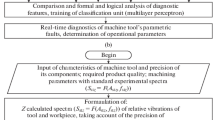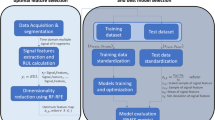Abstract
A method is proposed for diagnostics of the tool condition in metal-cutting machines. This method permits determination of the tool wear on the basis of information from force and vibration sensors. To determine the dependence of the wear on the vibration and cutting force, a diagnostic model based on bidirectional recurrent neural networks with long short-term memory (bidirectional LSTM networks) is employed. The architecture of such neural networks is outlined. Several diagnostic models are developed on the basis of different network architecture, and their accuracy is compared.




Similar content being viewed by others
REFERENCES
Yashcheritsyn, P.I., Teoriya rezaniya: uchebnik (Cutting Theory: Manual), Minsk: Novoe Znanie, 2006.
Ignat’ev, A.S., Wear and improving the performance of carbide cutting plates, Sovrem. Probl. Nauki Obraz., 2014, no. 3, p. 138.
Minaev, V., Maintenance and repair strategies and the efficiency of reparation works, Ekon. Zhizn’, 2012, no. 32 (9448), pp. 5–6.
Shestakova, I.G., Human capital in the digital epoch, Nauchn. Zh. Nats. Issled. Univ. Inf. Tekhnol., Mekh. Opt., Ser. Ekon. Ekol. Menedzhment, 2018, no. 1, pp. 56–63.
Goncharov, A.S. and Saklakov, V.M., Digital twin: an overview of existing solutions and prospective development, Materialy Vserossiiskoi nauchno-prakticheskoi konferentsii “Informatsionno-telekommunikatsionnye sistemy i tekhnologii (ITSiT-2019)” (Proc. All-Russ. Sci.-Pract. Conf. “Information and Telecommunication Systems and Technologies (ITST-2019)”), Kemerovo, 2018, pp. 24–26.
Omelchak, A., Fecak, S.I., and Idrisova, U.V., Dynamic processes in a machine-tool at high-speed, in DAAAM International Scientific Book 2016, Vienna, 2016, chap. 16, pp. 175–182.
Ferguson, M., Bhinge, R., Law, K.H., and Lee, Y.-T.T., Draft: a generalized method for featurization of manufacturing signals, with application to tool condition monitoring, Proc. ASME 2017 Int. Design Engineering Technical Conf. and Computers and Information in Engineering Conf. (IDETC-CIE2017), Cleveland, OH, 2017, vol. 4, pp. 1–10.
Maria, T.G.O., Combining shape and contour features to improve tool wear monitoring in milling processes, Int. J. Prod. Res., 2018, vol. 56, pp. 3901–3913.
Li, X., Lim, B.S., Zhou, J.H., et al., Fuzzy neural network modeling for tool wear estimation in dry milling operation, Proc. Annual Conf. of the Prognostics and Health Management Society, San Diego, CA, 2009, vol. 1, pp. 1–11.
Masalimov, K.A. and Munasypov, R.A., Neural network intelligent models with a prolonged short-term memory for diagnostics of the state of machines in mechanical engineering, Vestn. Ufimsk. Gos. Aviats. Tekh. Univ., 2018, vol. 22, no. 2 (80), pp. 138–145.
Graves, A. and Schmidhuber, J., Framewise phoneme classification with bidirectional LSTM and other neural network architectures, Neural Networks, 2005, vol. 18, pp. 602–610.
RodersTech RFM760, 2020. http://www.tritechtooling.com/equipment/roeders-rfm760/. Accessed June 20, 2020.
LeicaMZ12, 2020. http://www.lightglassoptics.com/Leica-MZ125-Stereomicroscope-on-A-Stand_p_1033.html. Accessed June 20, 2020.
Keras, 2020. https://keras.io/. Accessed June 20, 2020.
Funding
Financial support was provided by the Ministry of Education of the Russian Federation, project 0838-2020-0006 “Fundamental study of new principles for the creation of promising electromechanical energy converters with characteristics above the world level, with increased efficiency and minimum specific indicators, using new highly efficient electrotechnical materials.”
Author information
Authors and Affiliations
Corresponding authors
Additional information
Translated by B. Gilbert
About this article
Cite this article
Masalimov, K.A., Munasypov, R.A., Fetsak, S.I. et al. Diagnostics of the Tool Condition in Metal-Cutting Machines by Means of Recurrent Neural Networks. Russ. Engin. Res. 41, 252–256 (2021). https://doi.org/10.3103/S1068798X21030102
Received:
Revised:
Accepted:
Published:
Issue Date:
DOI: https://doi.org/10.3103/S1068798X21030102




